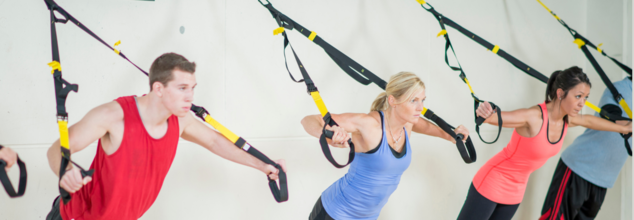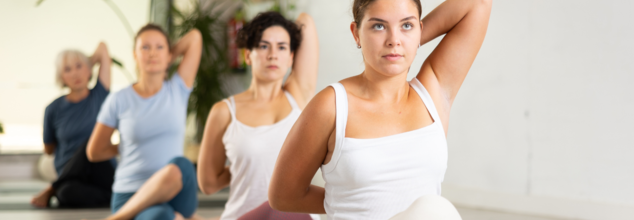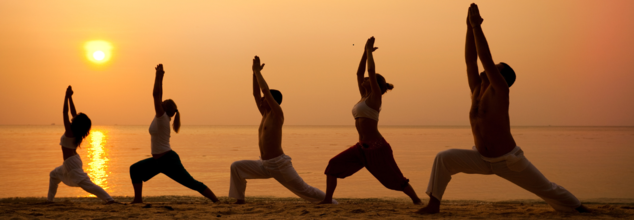- Health Conditions A-Z
- Health & Wellness
- Nutrition
- Fitness
- Health News
- Ayurveda
- Videos
- Medicine A-Z
- Parenting
- Web Stories

Credits: Canva
Is Your Daily Workout Unknowingly Training Your Body Into Bad Alignment?
Feeling like your daily workouts are making you stronger but also stiff or more hunched over? While exercise is vital for health, but little do you know that it is amazingly easy to develop habits which unintentionally prepare your body into poor alignment. All you have to do is tweak a couple of things to convert your exercise routine into strengthening fitness with alignment support.
In a world where fitness is glorified as a way to physical, mental and emotional well-being, daily workouts have become a lifestyle staple. From strength training to cardio sessions and yoga flows, most of us are on a mission to build stronger bodies and build better health. Yet, beneath those visible gains, a minor but significant challenge might be brewing- poor posture and body misalignment.
Amazingly, even the most diligent gym rats and health enthusiasts can be unknowingly perpetuating muscular imbalances that contribute to poor posture, chronic stiffness, and long-term discomfort. This isn't a matter of working out less, it's a matter of training smarter.
Posture is not merely the way you stand it's the way your body positions itself and moves in space. Ideally, the head, shoulders, spine, and pelvis should be in smooth alignment. But that rarely happens in real life. Most workout programs introduce muscular imbalances. Strengthening the front-body muscles such as the chest, abs, and hip flexors but not the back-body muscles including the mid-back, glutes, and hamstrings, can ruin this natural alignment.
Exercises like push-ups, bench presses, and crunches may deliver definition but can inadvertently tighten muscles on the front side of the body. Over time, this dominance pulls the shoulders forward, weakens the postural chain, and disrupts mobility — even when you’re otherwise “fit.”
How Repetition Can Reinforce Dysfunction During Workout?
Continuously doing bodyweight exercises or weight lifting with poor technique, particularly when loaded, not only restricts progress but also implants dysfunctional movement patterns. Slouching through rows, squatting with a hunch, or bending your neck to view form in a mirror can lock in postural dysfunction. The result? Repeated stiffness, limited motion, joint pain, and a posture that's not working for you but against you.
How to Realign Your Fitness Routine to A Stronger Body?
The solution to posture-degrading workouts isn't forgoing exercise; it's purposeful adjustment. Here are evidence-backed techniques to future-proof your posture and still get stronger.
1. Balance Push and Pull for Structural Symmetry
To develop a strong posture, balance is paramount. For each "pushing" exercise you perform (e.g., push-ups, chest presses, overhead presses), incorporate a "pulling" motion (e.g., rows, band pull-aparts, lat pulldowns). Pulling exercises engage the rear deltoids, trapezius, and rhomboids all-important muscles that stabilize the shoulder blades and avoid rolling forward of the shoulders.
In the same way, in lower-body exercises, don't leave it at squats and lunges. Include hinging movements such as Romanian deadlifts and hip thrusts to address the hamstrings and posterior chain, which attach the pelvis and spine. Synergy such as this returns your posture into balance.
2. Make Mobility a Priority as Part of the Workout
Mobility is not a choice. Without it, repetitive use tightens muscles that restrict range of motion and cause compensations that undermine posture and raise injury risk.
Regular or post-session mobility exercises can reverse this. Add:
- Wall Slides – Engage mid-back muscles and loosen tight pectorals.
- Three-Way Hip Flexor Release – Free the hips and reduce stress on the lumbar spine.
- Windmill Twists – Increase thoracic spine rotation and shoulder flexibility, decompressing the lower back.
Five minutes of mobility before or after exercise can enhance performance and correct posture in the long run.
3. Form Over Force
Ideal posture is not a static position—it's dynamic. With exercises, minor adjustments can solidify greater alignment:
- Head and Neck: Keep these in alignment with your spine; don't push your chin forward.
- Shoulders: Draw them back and down, away from your ears.
- Spine: Maintain a neutral spine — avoid excessive arching or slouching.
- Breathing: Breathe intentionally — exhale during exertion to support core engagement.
If you’re unsure, film your workouts or consult a certified trainer to ensure you’re not unknowingly reinforcing bad habits. Avoid relying solely on mirrors, as twisting to check your form can itself disrupt alignment.
4. Warm Up Right
Warming up your body with dynamic stretches such as foam rolling, lunges, and arm swings enhances circulation, fires up the correct muscles, and minimizes the risk of injury. Don't neglect static stretches either - light hip flexor or neck stretches can unlock tension prior to weight-bearing movements.
This warm-up phase prepares your posture by getting all major muscle groups fired up and mobile before training.
5. Rest and Recovery
Overtraining is a sneaky saboteur. When the body is not allowed sufficient recovery time, muscle fatigue takes over, causing poor form and, eventually, posture problems. Skipping rest days can cause dehydration, headaches, and muscle tension that force your body into unbalanced movement patterns.
Planning rest, staying hydrated, and applying active recovery days to mobility or light yoga are necessary to preserve both muscle gains and postural integrity.
6. Strengthen the Core
A solid core is the basis for proper posture. Crunches, however, will not be enough. Add planks, dead bugs, and bird-dogs that target deeper stabilizer muscles, such as the transverse abdominis and multifidus, that stabilize the spine from the inside out.
Prioritize controlled movement, consistent breathing, and neutral positioning — not speed or reps.
7. Consider Chiropractic Support for Better Alignment
For those dealing with persistent stiffness or alignment issues, periodic chiropractic adjustments can offer relief. Regular sessions can alleviate joint pressure, improve spinal alignment, and reduce postural strain from intense workouts.
Combine this with posture-aware training, and you’ll set yourself up for long-term strength — not just short-term gains.
Disclaimer: This article is intended for informational purposes only and should not be considered a substitute for professional medical advice, diagnosis, or treatment. Always consult with a certified fitness trainer, physical therapist, or healthcare provider before beginning any new exercise regimen, especially if you have existing health concerns or postural issues.

Practice This Yoga Pose For Enhanced Flexibility And Mobility
Yoga is a great way to start your day. When you exercise before you begin your day-to-day activities, you may notice how you feel rather refreshed and energized. Yoga has many stretches and poses that can help you strengthen your body along with keeping your muscles revitalized. One such yoga pose is Gomukhasana.
Gomukhasana, or Cow Face Pose in yoga, is a sitting pose. It is a pose that allows one to stretch deeply as well as test one’s endurance. When you translate it from Sanskrit, the name comes from "go" (cow) and "mukha" (face) because the final stage of the pose takes the shape of a cow's face. In the pose, your arms are positioned so one looks like the cow's mouth and the other like its ear. Gomukhasana helps make your shoulders, chest, and hips more flexible, while also improving your body's alignment and helping you relax. It's often part of yoga to boost your body and mind.
How Does It Benefit Your Body?
Eases Sciatica Pain
This yoga pose can help lessen the pain you might feel if you have sciatica, which is nerve pain in your lower back and legs. Doing it regularly might take some pressure off that nerve and make you feel better.
Good for High Blood Pressure
Cow Face Pose could be helpful if you're trying to manage high blood pressure naturally. It can help your body relax and get your blood flowing better, which might lead to healthier blood pressure numbers.
Helps Reproductive Health
Doing this pose regularly can gently work on and massage the organs in your body related to having children. This can be good for their overall health and how they function.
Fixes Stiff Shoulders and Posture
If your shoulders feel tight or you tend to slouch, Gomukhasana can really help. It stretches your shoulders and makes your spine longer, which can improve how you stand and sit over time.
Makes Hips More Flexible
This pose is great for making your hips move more easily. The way you position your legs gives a deep stretch to the outside of your hips and upper legs, helping them become more bendy.
Reduces Stress and Worry
Besides making your body feel good, Cow Face Pose can also calm your mind. Holding the pose and focusing on your breathing can help you feel less stressed and worried, bringing a sense of peace.
Step-By-Step Guide On How To Do It
- Start sitting in Dandasana (Staff Pose), with your legs straight out in front of you.
- Bend your right knee and bring your left foot to the outside of your right hip, tucking it under your right knee. At the same time, put your right foot on the outside of your left hip, lining up your right knee over your left knee.
- Sit up tall, feeling your sitting bones on the floor. Breathe in and make your spine long, stretching your arms out to the sides with your palms facing forward.
- Turn your right shoulder inwards, so your palm faces the wall behind you and your thumb points down. Move your right arm behind your back, bringing your hand up between your shoulder blades with your palm facing out.
- Reach your left arm straight up towards the ceiling, with your palm facing forward. Bend your left elbow and reach down to try and touch your right fingertips, maybe even holding fingers if you can.
- Your right knee should now be on top, and your left elbow pointing up.
- Gently squeeze your shoulder blades together on your back to open your chest. Hold this pose for a few breaths.

Credits: Canva
Yoga Can Help Reduce Chronic Pain, Here's How
Millions of people live with chronic pain that can disrupt daily life, making simple activities difficult and often leading to further physical and emotional struggles. Yoga, a low-impact practice combining movement, breath, and mindfulness, has proven to be an effective way to reduce pain and regain quality of life—especially after injury.
From Acute Injury to Chronic Pain
Acute injuries—like sprained ankles, muscle strains, or joint dislocations—are common among athletes and active individuals. These injuries usually heal within a few weeks or months. However, if pain from these injuries continues beyond six months, it becomes classified as chronic pain.
Chronic pain affects over 51 million adults in the U.S., with nearly 17 million facing high-impact chronic pain that restricts daily activities. One key predictor of this transition is the intensity and duration of the original acute pain. Pain rated high on the intensity scale is more likely to become persistent.
Interestingly, pain and injury are not always synonymous. Not everyone who has an injury experiences long-term pain, and chronic pain can exist without a clear injury. This happens when the nervous system stays on high alert, even after tissues have healed—a process driven by neuroplasticity.
Why Movement Matters
Despite the instinct to rest while in pain, research shows that too much rest can worsen symptoms. Movement helps maintain circulation, reduce inflammation, and calm the nervous system. Activities like yoga offer a gentle way to return to motion, especially when other forms of exercise feel too intense or risky.
Yoga also aligns with the biopsychosocial model of health, which views pain as a product not just of physical damage but also emotional and social factors. Fear, stress, and isolation can prolong healing. Yoga counters these elements through mindful breathing, stress reduction, and encouraging regular, supported movement.
Breaking the Cycle of Fear and Catastrophizing
Chronic pain can lead to a cycle of fear and avoidance. Worrying that movement will worsen pain may lead people to stop exercising entirely, which delays recovery. This mindset—often called "catastrophizing"—lowers the brain’s ability to produce natural pain-relieving chemicals and can even affect sleep and mood.
Mindfulness practices in yoga help break this cycle. When practiced regularly, yoga helps shift focus away from pain and promotes relaxation. Over time, the brain adapts and becomes less preoccupied with discomfort, allowing clearer thinking and improved emotional well-being.
The Importance of Social Support
Social isolation and poor mental health are both known to exacerbate chronic pain. Being part of a welcoming, supportive community—like a local yoga studio—can have a powerful effect on healing. Making connections and building friendships while engaging in movement encourages positivity and consistency.
Studies show that people with strong social ties or satisfying relationships cope better with pain and experience less disability. Yoga not only strengthens the body but also builds emotional resilience by fostering meaningful connections and community belonging.
Yoga offers a long-term, sustainable approach to managing chronic pain. It combines physical movement, emotional healing, and social interaction—all essential elements for recovery. While every pain experience is unique, yoga can help many people regain control, restore function, and return to the activities they love.

Credits: Canva
6 Mini Strength Workouts For People Who Hate Excising In Overcrowded Gyms
If you've ever skipped a workout because the gym was packed, noisy, or simply overwhelming—you’re not alone. For many, the thought of battling for machines or navigating crowded locker rooms is enough to kill any motivation but what if you could ditch the gym entirely and still get in a powerful strength workout? Mini strength workouts are short, efficient routines are gaining popularity for one simple reason they fit real life.
On your busiest days, you probably don’t have an uninterrupted hour to dedicate to strength training. But what about five minutes before your morning meeting? Or the 10 minutes after putting your kids to bed? These “movement snacks”, as trainers now call them are not only doable, they’re highly effective. Whether you’re in your living room, a quiet corner of the office, or even a hotel room, you can squeeze in these science-backed mini sessions without needing a single piece of equipment.
You may wonder: can five- or ten-minute bursts of exercise really make a difference? According to a 2023 meta-review in Sports Medicine, yes. Researchers compared the effects of traditional long workouts to shorter, accumulated ones spread throughout the day. The results? No significant difference in outcomes like blood pressure, fitness levels, and glucose control.
In fact, in some cases, mini workouts outperformed longer sessions in metrics like LDL cholesterol and body mass. These short bursts help stimulate metabolism, improve cardiovascular health, and deliver the same caloric expenditure as longer routines—provided they're spread out within the same 24-hour period.
What’s more, short workouts release endorphins, break up sedentary time, and help you build consistency—without the dread of a full workout session.
10-Minute Upper Body & Core Blast
This high-rep, low-equipment circuit alternates between face-down and face-up positions to maximize engagement while minimizing fatigue. The continuous motion targets core and upper-body strength efficiently.
How It Works: Complete the following exercises in order for the reps listed. Repeat the circuit for 10 minutes.
Plank Shoulder Taps – Builds shoulder stability and core strength
Leg Raises – Targets the lower abs
Pike Push-ups – Challenges the shoulders and arms
Hollow Hold Rocks – Deep core activation
Mountain Climbers – Cardiovascular and core workout
Bicycle Crunches – Oblique strengthening with a cardio twist
This circuit is perfect for early mornings or post-work stress relief. You’ll feel it immediately—and that’s the point.
Total-Body Reset in 10 Minutes
When you're short on time but want a full-body burn, this circuit covers every major muscle group with fundamental, effective moves. It's grounded in functional training and requires no fancy equipment.
How It Works: Perform each move for 30 seconds. Complete 4 rounds.
Bear Crawl – Activates core, shoulders, and quads
Sumo Squats – Glutes, inner thighs, and hamstrings
Hand-Release Push-ups – Builds explosive power and chest strength
Alternating Lunges – Functional lower-body movement
Reverse Plank Hold – Core and posterior chain activation
This workout is ideal when you want to feel strong, centered, and energized—all in the time it takes to heat up your coffee.
Why Mini Workouts Beat Gym Burnout?
Traditional gym sessions can sometimes feel like a chore. The prep, the commute, the crowd—it’s a lot. Mini workouts cut the fluff and deliver pure results in a fraction of the time. Plus, they empower you to take back control of your routine. No need to wait for machines or plan around gym hours. All you need is your body—and a little discipline.
Even more importantly, mini workouts promote consistency. You're far more likely to squeeze in four short sessions throughout the day than to commit to one long, draining gym workout. And that consistency? That’s what changes your body over time.
How To Build Your Personal Mini Workout Routine?
The beauty of mini workouts lies in their flexibility. You can stack a few throughout the day—say, 10 minutes in the morning, 10 at lunch, and another 10 after work—and reap similar benefits to a continuous 30-minute session. Listen to your body, mix in cardio and strength, and vary the muscle groups you target. Think of it as fitness snacking—only without the guilt.
You don’t need a gym membership—or even a full hour—to get stronger, healthier, and more energized. These mini strength workouts are not just alternatives; they’re power-packed solutions designed for real people with real lives. Whether you’re on a lunch break or escaping a packed gym, these 10-minute routines bring strength training home, office, or wherever you are.
© 2024 Bennett, Coleman & Company Limited



